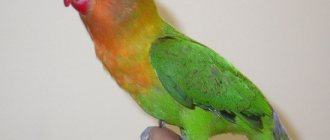Basically, our compatriots associate a cat with such a fluffy ball purring on the owner’s lap. But there are a lot of different breeds in the world that are radically different from stereotypical ideas.
Sometimes there are breeds and species that an unprepared person cannot look at without opening his eyes wide in surprise. They differ in size, habitat area, coat length, etc., but they are all united by their unique grace and habits.
Dune cat
sand cat- Dune cat
History of the species
The Little Desert Cat entered history in a very unusual way. The fact is that this species of cat was discovered twice.
In the middle of the last century, the French general Jean Auguste Marguerite organized an expedition to the Sahara Desert. Scientists discovered representatives of a new species of cat on the border of Libya and Algeria. The unusual cat was named in honor of the general who led the expedition - Felis margarita. The description was made by the French naturalist Victor-Jean-François Loshomme.
At the beginning of the next century, a Russian expedition led by Moscow explorer Sergei Ognev studied the Kara-Kum and Kyzyl-Kum deserts. They also met an unusual small desert cat and recorded the discovery of a new species.
Later, the misunderstanding was resolved - French scientists simply discovered a North African variety, and Russian scientists discovered an Asian one.
The sand cat is often called the Arabian or Sand cat. However, the name “velvet” is incorrect. The name of the animal is caused by associations with the dunes, among which it was found, and not with velvet.
What scientists still cannot explain is how this species of cat arose in the deserts and how it adapted to life in incredibly difficult conditions. The animals look so cute and seem so harmless that their very existence in the sands has given rise to many legends and fairy tales. Here is one of them about a tribe of people living in the desert more than four thousand years ago:
The leader of the community had a son who loved to draw on stones. When the tribe was attacked by enemies, one of the elders managed to turn the boy into a cat. He had to get to the nearby allied camp and call on them for help. When the soldiers arrived at the scene of the battle, there were no longer any survivors left there. From the rock paintings, people understood what had happened and began to look for the cat in order to return it to its human appearance. The boy disappeared - he could not come to terms with the death of his parents and went to the sands to look for them.
Since then, the little Sand Cat has been wandering the desert, searching in vain for his loved ones. It is very difficult for people to see him, only sometimes his sad face flashes in the distance, and his huge eyes look with hope at the drawings in the sand.
Mr. Cat Explains: Description and Natural Range
Felis margarita is perhaps one of the smallest wild cats. The only smaller ones are black-footed African cats, which barely reach a length of 50 cm and weigh no more than one and a half kilograms.
The body of the largest representatives of the Dune cat reaches a length of only 90 cm, of which about half is occupied by the tail. The average individual is only 65 cm.
The height of the animal at the withers is from 20 to 30 cm, the weight of an adult male individual is 2-3 kg. Females are much smaller.
The animal has a massive head; it looks especially wide and flat due to its voluminous cheeks and low-set small pointed ears, which are located almost on the sides of the head.
At the base, the ears are very wide, which helps to better capture sounds and hunt; they are densely covered with long fluff inside and do not have brushes.
Large golden eyes with a vertical pupil, a narrow neat nose on a pointed muzzle, lush earpieces and vibrissae hiding a small mouth complete the appearance of a cute mysterious creature.
Thick and soft sandy-colored fur is long enough to protect against temperature changes in the desert; hard fur grows on the paw pads between the toes, which helps to avoid burns from the hot sand.
The animal’s huge eyes shine unusually brightly in the sun and can reveal the presence of the animal. The sand cat is aware of this feature and always lowers its eyelids when hiding or sitting in ambush and waiting for prey.
Coarse hairs growing between the toes not only protect the paws from the hot soil, but also help to hide, since due to them the cat does not leave marks. In addition, they increase the support area and prevent you from falling into quicksand.
The detailed exterior of the Dune Cat can be described as follows:
- The eyes are large, round, with a yellow iris. In the rays of the sun they become like a crack. The dark pupil is vertical.
- The nose is narrow, elegant with a small flat lobe from soft pink to deep sandy color.
- The ears are wide at the base, of medium height, with pointed tips, set wide and low.
- The head is large and wide with a low, flat forehead and high fluffy “sideburns” on the cheekbones.
- The body is small and strong, from 40 to 52 cm.
- The limbs are short and strong, with a powerful fur trim.
- The claws are short and sharp, but often worn down due to climbing rocks.
- The tail is long and fluffy, making up at least 40% of the body size, 23-29 cm.
- Wool of medium length, printed.
- Color depends on the habitat. The color of the coat varies from golden, light sandy to grayish. This variability in color is explained by the color of the soil, because the animal should not stand out against its background, but simply blend in with it. The tip of the tail is usually dark, the chest, abdominal area and the inside of the legs are lighter. In winter, the hair becomes darker and loses its brightness.
Habitat and lifestyle
The range of the Dune cat is the deserts of North Africa, they are found in Algeria, Southern Morocco, Chad, Nigeria, in all regions of the Arabian Peninsula, as well as in Central Asia - Uzbekistan, Turkmenistan, partly Kazakhstan and Pakistan. Previously, Sand cats were also found in the arid zones of Israel and Jordan, but at the moment these populations are almost exterminated.
The uniqueness of this representative of the cat family is that it chooses habitat areas that would seem impossible for this predator. They have the hottest and driest climate and are practically devoid of water sources.
Sometimes Dune cats can be found in scattered rocks adjacent to deserts, as well as in rocky valleys overgrown with dry bushes. Here they set up their burrows. Some populations also have access to bodies of water.
Thanks to their thick undercoat, cats tolerate both heat and cold well.
They hunt at night, and during the day they sleep in abandoned burrows, or independently dig small compact holes for themselves.
Habitat and role of desert cats in the ecosystem
Arabian cats inhabit the driest places on the planet. The main requirement for the site is the presence of dunes, dunes and dry bushy plants. The main settlement areas are located in the following parts of the planet:
- Sahara (Morocco, Algeria, Niger, Chad);
- Arabia Peninsula (Arabian Desert);
- central Asia (Kazakhstan, Turkmenistan and Uzbekistan);
- Pakistan.
Every animal has its place in the ecosystem. If the need for a species is lost, then its representatives cease to exist. The sand cat has only recently been studied, but it is clear that it appeared long before it was discovered by the French. This means that nature still needs this small predator. Desert cats exterminate rodent pests and can kill snakes. The cats themselves can suffer from larger predators (for example, lions). All this characterizes the sand cat as one of the links in the food chain.
Video: Dune cat kittens hiding in the grass
Varieties of the Dune cat
Scientists today distinguish four subspecies of the Dune cat:
- Felis margarita margarita;
- Felis margarita harrison;
- Felis margarita scheffeli;
- Felis margarita thinobia.
These populations differ somewhat from each other in size and coat color. This division is determined by the natural habitats of animals.
Dune cat Felis margarita margarita
The first group belongs to North Africa and is found mainly in the Sahara.
In 1938, scientist Reginald Innes Pocock also described two more Algerian varieties of Sand cats:
- Felis margarita meinertzhageni;
- Felis margarita aïrensis.
The first subspecies is found in the Algerian Sahara, the second in French Sudan. But today these taxa are considered invalid, and all animals are classified as the main nominee.
Margarita Margarita Dune cats have the brightest fur color, distinct sea markings, two to six black tail rings, and the smallest body size.
Sand cat variety Felis margarita harrisoni
Felis margarita harrisoni is believed to inhabit exclusively desert areas of the Arabian Peninsula. They are usually called Arabian sand cats. Also found in 2001 in the Syrian desert near the ruins of Palmyra. They are medium-sized animals with golden fur and bright markings on the body and tail.
Dune cat of the Scheffeli subspecies
Felis margarita scheffeli is a subspecies of the Sand Cat native to Pakistan. The species is described based on seven specimens of animals captured in the Nushke desert and killed in captivity. More often in scientific literature they are called Pakistani sand cats.
The fur of these animals has a distinct gray tint, but the markings on the face and tail are bright, with up to eight dark rings.
The national Red List of Pakistan Mammals has listed the sand cat as a critically endangered animal since 2003.
Asian sand cat
Felis margarita thinobia - inhabitants of the Caspian coast and Central Asia. It was this subspecies that was discovered by Sergei Ognev in the Kara-Kum and later described by Reginald Innes Pocock. These animals have a darker grayish fur color, faint markings on the face and tail, and are larger than their Saharan counterparts.
Exterior features of the black-footed cat
Looking at popular cat breeds with photographs and names, among which there are references to black-footed cats, one can note the unique external features of the animal. They help him survive and hunt in the deserts of Namibia, Botswana, Kalahari, Zimbabwe and Angola. The color of different representatives of the breed is of the same type. At the same time, cats living in different regions may change the shade of their coat - from sand to red-brown.
Let's look at the characteristic features of a cat's exterior, including:
- stocky build (which makes cats difficult to climb trees);
- wide head proportional to the size of the body;
- round expressive eyes;
- black paw pads covered with lint (to protect the animal from the hot sands of the desert);
- ears are large, round in shape;
- the tail is of medium length, the fur on it is colored in rings, and the tip is always dark in color.
Character and behavior of the Dune cat
It is difficult to find food in sufficient quantities in the desert, so Dune cats constantly migrate.
As shelters in conditions of constant movement across desert terrain, Sand cats rarely dig holes on their own; more often they use abandoned dens of other animals, mainly foxes and porcupines.
They dig small holes very quickly thanks to their short and strong legs. Most often, animals sit in them during the day, and at dusk they go out hunting.
When leaving the shelter, the Dune Cat freezes for several minutes and carefully studies the surrounding space in order to notice the enemy in time. With exactly the same precautions, the small predator returns to its lair.
The uniqueness of Sand cats is that these animals can live in the absence of water. Their body is able to accumulate liquid, extracting it from any food.
To ensure that precious moisture is wasted to a minimum, animals do not go out into the scorching rays during the day, but shift their hours of greatest activity to the evening, night and early morning.
The sand cat is very small, but swift. During the night he is able to cover an area of about ten square kilometers. The animal runs, practically lying flat on the sand and lowering its head low, which creates a highly streamlined body. At the same time, the animal is capable of reaching speeds of up to 40 km/h. This method of movement, coupled with a high speed of movement, allows the cat to remain almost invisible and blend in with the sand. Even in sunlight, few predators are able to notice a moving Dune Cat.
In addition, it is an unusually intelligent animal. If a person shines a spotlight on it while hunting, the animal closes its eyes so as not to give itself away by the reflection of the iris.
Having adapted to a hot and dry climate, Sand cats really do not like precipitation, which is extremely rare in the desert, but possible in the adjacent territories. In order to wait out the rains, cats dig deep holes, up to 1.5-2 meters deep.
Despite the fact that Dune cats prefer to lead a solitary lifestyle, they are rather friendly towards their fellow cats, do not enter into confrontation and are even able to shelter them in their burrow. Due to the minimal amount of living life in the desert, Dune cats are excellent hunters.
The predator compensates for its miniscule size with the thoughtfulness of its attack and the swiftness of its throw. The habit of stockpiling and unpretentiousness helps these animals survive in conditions of total food shortage.
The sand cat will not refuse even a snake. The Arab variety is especially famous and interesting for these deadly fights. The predator acts in a unique way and often defeats even a viper - it unexpectedly hits its opponent on the head, stunning the prey, and then finishes it off by biting its neck.
In winter, when the minimum life in the desert that is active in the summer freezes, Dune cats move closer to human settlements. Although it is people who are the main enemies of these animals. Jackals, monitor lizards, bird predators, and caracals are also dangerous for sand cats. Despite the fact that hunting the Sand Cat is very difficult, man does not give up his claims to this prey. Most often, animals are caught for subsequent sale.
The greatest harm to the population is caused by humans ineffective management of pasture resources and eradication of the natural biotope.
Extraordinary desert cat
Don't be fooled by the cuteness quotient. This is the sand cat, or Felis margarita, a little-known species of desert cat. In the wild, it lives in places that are too hot and dry for any other cat - the deserts of Africa and Asia, including the Sahara. This is the only species of desert cat known to us. This cat itself is a tough nut to crack.
It also lives in the Arabian Desert, Iran and Pakistan, but despite such a wide distribution, the cat is not found in European descriptions until 1858. Victor Loche, a French soldier and naturalist exploring the Northern Sahara, first discovered the sand cat waiting patiently there for him to finally describe it.
Victor named it Felis margarita in honor of Jean August Margueritte. Although the name sounds half species and half cocktail, it was Marguerite who led the expedition during which Lohe "discovered" the cat, and was a prominent army general who served in Algeria. He died after being mortally wounded during a large cavalry charge at the Battle of Sedan during the Franco-Prussian War. Lohe sought to preserve his name for posterity, so he named the discovered cat in honor of Marguerite.
To some extent, the sand cat can be mistaken for a house cat, but there are differences between the two, such as a very wide head. In addition, the ears are much wider than those of a domestic cat, which means that the sand cat can hold them horizontally when hunting. These cats are slightly larger, growing ten centimeters longer than a domestic cat, give or take six centimeters.
As with length, they grow about 6 cm taller than a domestic cat. Their sandy-colored fur also distinguishes them from house cats, as do the pale stripes that can be seen on their paws and backs. Adding to their attractiveness is the white chin and underparts, as well as the pale red stripes that run down the cheeks from the eyes.
Another difference we know of that is hard to see in these photos is the fur between the cat's toes. You might think that the last thing a desert cat needs is too much fur, but it helps insulate their paws from the hot sand that cats use to chase prey. Fur is also needed to cover tracks.
The hollow structure that includes part of the middle and inner ear, the auditory bulla, is also larger than that of the domestic cat. This helps make their hearing sharper and allows cats to hear the vibrations of the sand. Finally, their mucous membrane (the membrane around the eyelids) is highlighted in black, giving the appearance that the cat has eyeliner.
Their habitat is so desolate that the sand cat sometimes has to wander for months without water. Instead, they survive on the water in their food, which is usually rodents, but they can also feed on birds, lizards and insects. They will not eat "human" food. Cats do not live in sand dunes, but prefer flat or gently sloping areas, retreating to their burrows when it gets too hot even for them.
Since they primarily feed on rodents, cats dig a lot. Sneaking close to the ground, they use their highly sensitive hearing to detect the sound of a rodent burrowing beneath them. When they hear something similar to this, they dig in that place to catch their prey.
Although they are not very social and only gather to mate, sand cats do not defend their territory. Many cats even share a hole with each other. One cat goes hunting, while the other stays in the hole and rests. When the first one returns, the other leaves.
Just like its obvious enemy (us!), the sand cat is not at the top of its own food chain. It is located before wolves and even sometimes snakes and large birds of prey. However, these cats are fearless creatures and are not afraid of humans when they come into contact with us.
Hunting for the sand cat is prohibited in only half of the countries in its range, although it is hoped that this law will soon spread throughout its range. Recently, they were even reintroduced into the wild in Israel, where the animals had previously been extirpated. The sand cat remains one of the least known but beautiful felines on the planet.
Nutritional Features
Due to the scarcity of protein food in the desert, Sand cats are ready to eat absolutely any food:
- rodents (mice, gerbils, gophers, jerboas);
- spiders;
- lizards;
- small birds;
- hares;
- insects;
- snake.
At the same time, the Dune Cat, even if it is full, will never throw away the remains of its prey; it will definitely hide it in a secluded place. It will simply bury it deep in the sand, and its subtle sense of smell will help you find the supply for the next day.
Reproduction
These animals have offspring once a year. There is no clearly established mating season. Thus, the North African subspecies usually breeds from January to April, the Pakistani subspecies in September-October, and in the sands of the Kara-Kum, the rut begins in April-May.
At this time, males betray their silent nature. They actively call on females, who are also able to show their voice, signaling their readiness to mate.
The cries of these animals bear little resemblance to meowing, but rather resemble the barking of small breed dogs. That’s why Barkhannikovs are often called barking cats.
Sand cats carry their young for about two months, 60 to 70 days. A litter usually contains two to eight babies, although the average number is three to four. Pairs are formed only during the rutting period; the female bears, gives birth to, and feeds the cubs most often alone.
The female prepares a safe den in advance, in which she gives birth to completely blind babies, weighing no more than 28-33 g. Within two weeks, the kittens open their blue eyes and triple their weight by the first month of life. The iris begins to turn yellow by the third or fourth month of life.
From the second month, the mother begins to gradually accustom the cubs to solid food. The kittens usually stay next to her for up to six months, actively learning methods of hunting and survival in the desert.
Sexual maturity occurs very unevenly and depends on the individual characteristics of the individual, from 9 to 15 months. Cats leave their family at the age of six months, kittens live with their mother longer.
Most recently, they managed to obtain the offspring of the Dune Cat in the Israeli zoo, and scientists were able to observe with their own eyes all the periods of growing up of three kittens.
Interesting Facts
Even at a young age, every Blackfoot cat has the spirit of a fierce hunter. Eyewitnesses observed a predator tracking an ostrich, whose weight exceeds 80 kg.
Ant Tigers are extremely similar in appearance to domestic cats, but there are very few of them left in the wild.
In 1962, scientist Paul Leichausen conducted an interesting experiment and crossed the Black-footed cat with an ordinary pet.
There are at most twenty such pets in private collections in the United States of America and about forty to fifty more in the rest of the world.
In 2011, two in vitro-grown Black-footed cat kittens were born at a research center in New Orleans - born from frozen embryos, the first case of ecopolar fertilization in a wild cat. Their surrogate mother is female Bijou, and their father is Ramses from the Omaha Zoo, and his sperm was collected and frozen in 2003.
In 2007, sperm was injected into the eggs of a female Zora, and the embryos were frozen for six years. After the transfer of the Bijou embryos, 69 days passed and two kittens were safely born on their own.
The black-footed cat is the smallest member of the cat family on the African continent.
Captivity
Information on the size of the world population of the Dune Cat varies greatly. The collection of accurate data has only recently begun thanks to the development of video surveillance.
Already in this century, the Dune Cat was taken under the protection of zoological centers. They voice the population figure of 50 thousand individuals, but hardly anyone can vouch for its accuracy due to the high secrecy of the animals.
Now the Sand Cat is listed in the International Red Book as the most vulnerable and close to extinction species.
This animal is kept in some large zoos in the world, which greatly value such rare pets. The number of adults living in captivity is believed to be only nine. Occasionally, animals travel to other zoos to breed and produce offspring.
These rare endangered animals living in zoos are known to the world by name. For example, the Kalahari cat, the marriage partner of the Israeli cat Rotem, came to visit a friend from Sweden. The result of this visit was the birth of three Sand kittens. This is very rare, since in captivity these animals have very poor contact with each other and cases of the birth of cubs are rare. In addition, captivity is stressful for mothers and they often abandon their offspring, which leads to the death of their babies.
Is it possible to keep a Dune cat at home?
The miniature size and external similarity of this desert predator to domestic cats often makes people forget about the wild nature of this animal. All cases of keeping the Dune cat at home are isolated.
There is very little information that can help make cohabitation between humans and desert predators correct. At a minimum it is necessary:
- It is imperative to ensure low humidity in the premises, as the Sand Cat is accustomed to the dry and hot desert climate.
- It is advisable to strictly regulate the temperature in the room or enclosure and not allow significant changes.
- It is necessary to strictly adhere to the terms of deworming and vaccination and monitor the health of the pet.
- The animal should be provided with a large area for activity.
- Provide a complete diet consisting mainly of protein foods, namely live food and raw meat. For an adult, at least 0.5 kg is required, for example, a bird.
- Use vitamin supplements in feeding.
So far, accumulated experience suggests that the Dune cat can live fully in captivity from 10 to 15 years.
Animal health
Although the Serval is healthy, vaccination is recommended for him in the same way as for other domestic cats. A veterinarian will not give a cat a vaccine that contains active viruses, as this can cause illness and death.
The cat will not say what is bothering it, so you need to focus on its atypical behavior and movements around the house. If there is any doubt, go to see a doctor.
Diarrhea requires the most attention. This is a direct road to dehydration, and in a short time. If your Serval cat has diarrhea, intravenous treatment may be required. If you have loose stools twice, you need to go to the vet. They look for the cause of the disease and prescribe adequate treatment.
The serval's paws grow quickly, so during the period of active growth of the animal you need to keep an eye on it during active games and running. If a small cat falls, it can damage its growing paws.
Issues of sterilization and castration are resolved if breeding at home is not planned. Cats tend to mark their territory, so castration is often a necessary measure. This is done at the age of 7-8 months.
How long do domestic servals live?
The life of Serval cats in natural conditions lasts 10-12 years. You need to feed yourself and not be killed yourself. Living conditions are much less comfortable than with a loving and caring owner. And care works wonders: if a pet is properly looked after, well fed, and given annual vaccinations, then its lifespan increases. The domestic Serval cat lives 15-20 years
, which makes its owner very happy.
Purchasing a Dune Kitten
Purchasing a Dune Cat kitten is almost impossible today. Since there are no specialized nurseries and breeders, and zoos are prohibited from selling kittens to private individuals. And the number of these animals in captivity is so small that this is simply impossible.
However, on the smuggling market it is known that the price of an animal starts from six thousand dollars. However, you should not even think about such an acquisition, since retribution for breaking the law is inevitable.
In order to increase the natural population of these rare animals, decades of work by zoological centers, environmental organizations, safari parks, nature reserves and zoos are required.
Today it is too early to think about domesticating and taming the Dune Cat; for now, this animal should live only in its natural habitat to maintain the harmony of the ecological system.
1111











